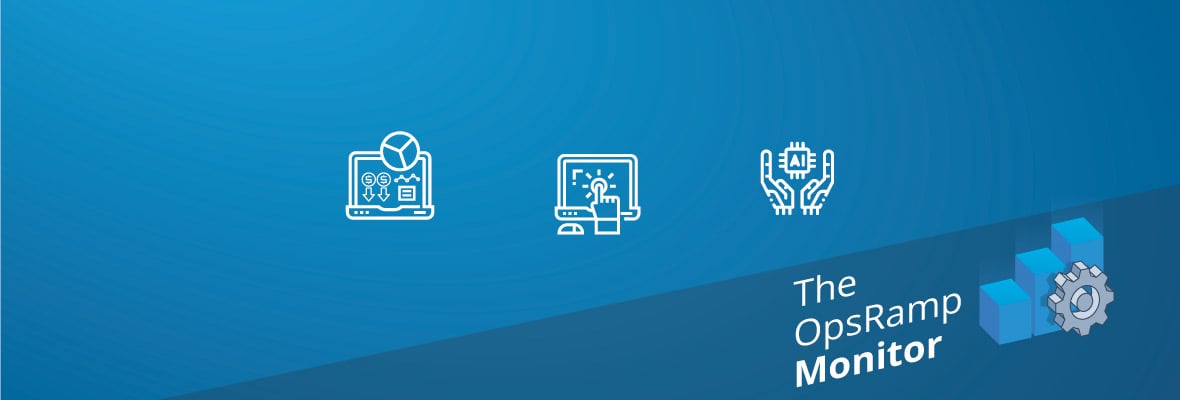Top Weekly Reads in IT I&O
The OpsRamp Monitor is OpsRamp’s top weekly review of interesting developments and emerging trends in IT operations. Subscribe to our blog for the latest and greatest in monitoring, DevOps, AIOps and cloud computing and stay on top of everything Ops.
In this issue:
- Easy ways to cut IT costs
- The role of self-service tools in IT
- Tiny AI is coming
- Promising career: data engineer
Time for an IT fire sale? CIOs are under the gun from their bosses to keep it tight. This might not be as hard as you think and infrastructure people can help. A Gartner op-ed appearing in CIO Dive laid out 10 rules when assessing IT cost reduction options, such as by first finding those areas which have the most impact on cash: “for instance cloud savings in SaaS or IaaS as opposed to reducing owned hardware assets (which only made up 13% of cross-industry IT spending by asset category in 2018).” The Gartner researcher also gave some examples of “easy ways” to cut the fat, including decommissioning underused infrastructure assets, adopting IaaS and canceling excessive, duplicate or unused software licenses.
The age of self-service. My 80-year old mother is not a fan of self-service; she wants to pick up her $1,000 iPhone, dial the numbers, and talk to someone pronto when she has a problem. But many people today prefer to help themselves and it's easy to do so with technology. Now self-service tools are helping everyone work smarter and more independently regardless of their role and level of tech expertise.
Gartner predicts that by 2023, 90% of enterprises will not be able to scale DevOps initiatives without a self-service platform that provides a “digital toolbox” of I&O capabilities so that DevOps teams can create, release and manage products consistently at scale. In a recent interview for the OpsRamp Blog, IT workplace expert Martha Heller discusses how self-service tools, including low-code platforms, are helping IT leaders keep pace with the acceleration of digital change by enabling business users to accomplish minor technical tasks on their own--such as developing a bot, interactive report or provisioning a cloud resource.
Tiny AI optimizes edge computing. MIT Technology Review published its top 10 breakthrough technology predictions on Wednesday. Among the eclectic list of inventions compiled by MITR’s editor is tiny AI: “Starting in the present day, AI will become even more functional, independently running on phones and wearables. This ability would prevent devices from needing the cloud to use AI-driven features.”
Shunning the cloud’s expense and latency when such things really matter is the promise of edge computing. Information Week published an extensive explainer about tiny machine learning engineering, which is worth your 7 minutes between meetings. Here’s a snippet: “Over the past several years, open-source AI-model compilers have come to market to ensure that the toolchain automatically optimizes AI models for fast efficient edge execution without compromising model accuracy.”
The list of compilers includes AWS NNVM Compiler, Intel Ngraph, Google XLA and NVIDIA TensorRT 3. The author defines the Tiny ML movement as new approaches that enable “on-device AI workloads to be executed by compact runtimes and libraries installed on ultra-low-power, resource-constrained edge devices.”
5G and IoT elicit yawns, for now. It’s a tale as old as time (in Silicon Valley). Scientists create a breakthrough technology to solve a big business problem. Executives hear about it for years. It launches with great fanfare but yet, interest is lukewarm.
In this case, we’re talking about the release of 5G wireless. While the problem 5G solves for--sluggish response times from using video and other high-bandwidth, data-intensive apps and services--is real, many companies are still in the planning stages of adoption. A survey by TechRepublic focused on the impact of 5G accessibility on IoT projects: “Despite promises of higher bandwidth, low latency, and ultra-reliability, more than half (56%) of the survey respondents said that 5G availability is not accelerating IoT projects in their organizations.” One reason why is because 4G works “well enough.” However, when they get around to deploying 5G, 61% of those surveyed cited that remotely monitoring assets in the field was the most popular IoT project powered by 5G availability.
Looking for a new career track in IT? Data engineers are in demand, even though they may not have quite the glamour profile as the data scientist. The New Stack reports that data engineers develop, build, test, and maintain databases, processing systems, and other architectures. The author compiles data from LinkedIn to show the relative dearth of qualified candidates for data engineering jobs compared with data scientist jobs. “For your data endeavor to succeed, you’ll need the expertise of data engineers to build the infrastructure and prepare the data, as well as the skills of data scientists who use this data to develop analyses, algorithms, and research. A shortage of talent in either field can only raise manpower costs and doom the entire data science project.”
Next Steps:
- Read more about our Winter 2020 Release in the blog.
- Read why HPE invested in OpsRamp.
- Subscribe to the OpsRamp Blog!






